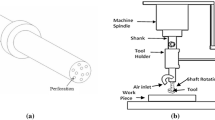Abstract
Machine learning approaches can help facilitate the optimization of machining processes. Model performance, including accuracy, stability, and robustness, are major criteria to choose among different methods. Besides, the applicability, ease of implementations, and cost-effectiveness should be considered for industrial applications. In the current study, we present the Gaussian process regression model to predict the material removal rate during electrical discharge diamond surface grinding of Inconel-718. The model uses descriptors that include the wheel speed, current, pulse-on-time, and duty factor. The model is simple and manifests high accuracy and stability, which contributes to fast material removal rate estimations. By combining the optimization results from the Taguchi method and GPR approach, it is expected that more quantitative data can be extracted from fewer experimental trials at the same time.



Similar content being viewed by others
References
Schwartz J, Koch CC, Zhang Y, Liu X Formation of bismuth strontium calcium copper oxide superconductors. U.S Patent US9773962B2, September 26, 2017
Zhang Y, Johnson S, Naderi G, Chaubal M, Hunt A, Schwartz J (2016) High critical current density Bi2Sr2CaCu2O x/Ag wire containing oxide precursor synthesized from nano-oxides. Supercond Sci Technol 29(9):095012
Zhang Y, Koch CC, Schwartz J (2016) Formation of Bi2Sr2CaCu2O x/Ag multifilamentary metallic precursor powder-in-tube wires. Supercond Sci Technol 29(12):125005
Zhang Y, Koch CC, Schwartz J (2014) Synthesis of Bi2Sr2CaCu2Ox superconductors via direct oxidation of metallic precursors. Supercond Sci Technol 27(5):055016
Tso PL (1995) Study on the grinding of Inconel 718. J Mater Process Technol 55(3–4):421–426
Choudhury SK, Jain VK, Gupta M (1999) Electrical discharge diamond grinding of high speed steel. Mach Sci Technol 3(1):91–105
Dandekar CR, Shin YC (2012) Modeling of machining of composite materials: a review. Int J Mach Tools Manuf 57:102–121
Siddiquee AN, Khan ZA, Goel P, Kumar M, Agarwal G, Khan NZ (2014) Optimization of deep drilling process parameters of AISI 321 steel using Taguchi method. Procedia Mater Sci 6:1217– 1225
Mali HS, Unune DR, Tiwari S (2014) Modelling and prediction of material removal rate in electrical discharge diamond surface grinding process of Inconel-718. In: Proceedings of 5th AIMTDR, pp 822
Zhang Y, Xu X (2020) Curie temperature modeling of magnetocaloric lanthanum manganites using Gaussian process regression. J Magn Magn Mater 512:166998
Zhang Y, Xu X (2020) Machine learning lattice constants for cubic perovskite \(a_{2}^{2+}{{BB}}^{\prime }o_{6}\) compounds. CrystEngComm 22:6385–6397
Jong WR, Huang YM, Lin YZ, Chen SC, Chen YW (2020) Integrating Taguchi method and artificial neural network to explore machine learning of computer aided engineering. J Chin Inst Eng 43(4):346–356
Voß S (2000) Meta-heuristics: The state of the art. In: Workshop on local search for planning and scheduling. Springer, Berlin, pp 1–23
Lela B, Bajić D, Jozić S (2009) Regression analysis, support vector machines, and Bayesian neural network approaches to modeling surface roughness in face milling. Int J Adv Manuf Technol 42(11–12):1082–1088
Zuperl U, Cus F (2004) Tool cutting force modeling in ball-end milling using multilevel perceptron. J Mater Process Technol 153:268–275
Aykut Ş , Gölcü M, Semiz S, Ergür HS (2007) Modeling of cutting forces as function of cutting parameters for face milling of satellite 6 using an artificial neural network. J Mater Process Technol 190(1–3):199–203
Akıncıoğlu S, Mendi F, Çiçek A, Akıncıoğlu G (2013) ANN-Based prediction of surface and hole quality in drilling of AISI D2 cold work tool steel. Int J Adv Manuf Technol 68(1–4):197–207
Akıncıoğlu S, Mendi F, Çiçek A, Akıncıoğlu G (2013) Prediction of thrust forces and hole diameters using artificial neural networks in drilling of AISI D2 tool steel with cemented carbide tools. Akademik Platform Mühendislik ve Fen Bilimleri Dergisi 1(2):11–20
Bull AD (2011) Convergence rates of efficient global optimization algorithms. J Mach Learn Res 12(Oct):2879–2904
Diebold FX, Mariano RS (1995) Comparing predictive accuracy. Journal of Business and Economic Statistics 13:253–263
Harvey D, Leybourne S, Newbold P (1997) Testing the equality of prediction mean squared errors. Int J Forecast 13(2):281–291
Zhang Y, Xu X (2021) Machine Learning Glass Transition Temperature of Polyacrylamides using Quantum Chemical Descriptors. Polymer Chemistry. https://doi.org/10.1039/d0py01581d
Author information
Authors and Affiliations
Corresponding author
Ethics declarations
The article has been written by the stated authors who are all aware of its content and approve its submission.
Conflict of interest
The authors have no competing interests.
Additional information
Author contribution
Yun Zhang: conceptualization, data curation, investigation, methodology, writing–original draft, writing–review and editing
Xiaojie Xu: formal analysis, visualization, software, methodology, writing–original draft, writing–review and editing
Availability of data and materials
Data used in this work have been properly cited within the article.
Consent for publication
All listed authors approve to publish.
Publisher’s note
Springer Nature remains neutral with regard to jurisdictional claims in published maps and institutional affiliations.
Rights and permissions
About this article
Cite this article
Zhang, Y., Xu, X. Predicting the material removal rate during electrical discharge diamond grinding using the Gaussian process regression: a comparison with the artificial neural network and response surface methodology. Int J Adv Manuf Technol 113, 1527–1533 (2021). https://doi.org/10.1007/s00170-021-06701-7
Received:
Accepted:
Published:
Issue Date:
DOI: https://doi.org/10.1007/s00170-021-06701-7



